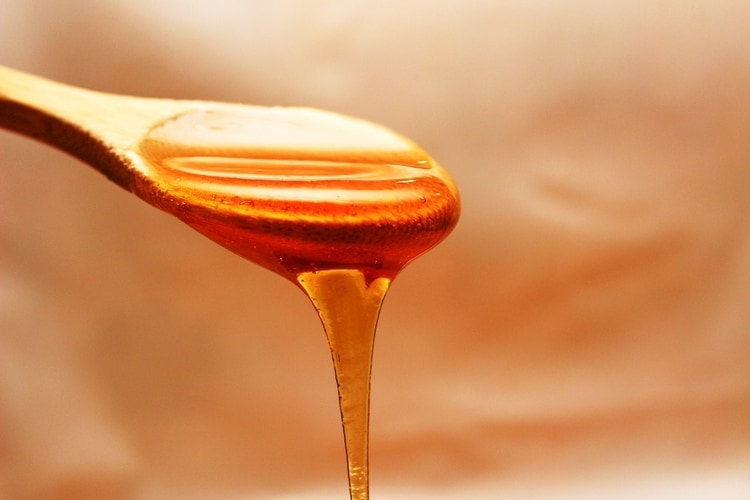Honey is a versatile ingredient in food used throughout the world. It is used to sweeten foods and drinks with its unique flavor. As with many other ingredients, though, honey can have an impact on the chemistry of your homebrew that you should consider before using it in your recipe.
What happens when you add honey to homebrew? Honey adds 100% fermentable sugar, which can be eaten by the yeast in your beer, potentially increasing the alcohol content if added during fermentation or increasing carbonation if added after fermentation is complete.
Read on to hear more about how honey may impact your alcohol content and add to carbonation, other impacts to consider, and other ingredients to use for a honey flavor.
Why Honey?
Honey typically stars as the main ingredient in home brewed meads.
To make mead, the homebrewer only needs to mix honey and water together, add yeast, and wait.
The waiting part is often the downside to making mead, whereas adding honey to beer can produce a drinkable beverage in just a few short weeks.
However, honey can be used to add flavor and body to many different styles of beer.
It’s a highly fermentable sugar that can complement specialty or seasonal beers, like pumpkin pie spice, or Christmas blends.
Adding honey to beer can help increase the alcohol content of your brew without adding too much body.
It’s a great way to create a strong, light beer.
Honey is mostly sugar, but also includes amino acids, vitamins, minerals, water, and complex carbohydrates.
Wild yeast may also be present.
If added prior to boil, the heat can kill any wild yeast or microorganisms present in the honey.
Honey can also add a bit of sweetness to the flavor if added at the proper time.
When to Add Honey to Homebrew
The honey flavor remaining in your homebrew depends on what stage of the homebrewing process you add the honey.
If you add honey during the boil prior to fermentation, there will be little to no honey flavor in the beer.
The honey will provide fermentable sugar that will add to the alcohol content.
If you add the honey during the middle of the boil, you will still have some light flavor.
Adding the honey after boiling will provide the most flavor prior to fermentation.
Adding the honey after the boil means that it won’t be pasteurized.
If you add during peak yeast fermentation, about two to four days into fermentation, the yeast will break down the complex sugars in the malts before having a chance to turn to the simple sugars of the yeast.
When added to the end of fermentation, most of the flavor and aroma will be preserved, but the honey will not add much to the final alcohol content.
Pasteurization
Most brewers try to maintain a sanitary brewing process, taking all ingredients through a boil to make sure that any wild yeast, bacteria, or cross-contamination have been eliminated.
However, boiling honey can damage the chemical composition and eliminate much of the flavor and aroma.
Other brewers do not believe that pasteurizing honey is necessary due to its natural antibacterial properties.
National Geographic even described the kind of honey in the pyramids of Egypt thousands of years old that was still edible.
Most mead home brewers strongly caution against overheating honey.
There are 2 methods for pasteurizing honey:
- include the honey in the boil of your wort
- conduct a lower temperature pasteurization for a long duration, such as warming the bottle in a saucepan of water at about 176°F (80°C) for two hours.
How Honey Impacts Fermentation
All homebrewers should know that yeast eats sugars in the wort to produce alcohol and carbon dioxide.
These byproducts of the yeast’s digestion give the homebrew it’s alcohol content (ABV), and later it’s carbonation.
Typically, yeast will eat the sugars from the grains in the wort, whether you use all grains, liquid malt extract, or dry malt extract.
Honey contains sugars called fructose and glucose.
Different types of honey may have different concentrations of sugar and water.
If you’ve ever poured honey, you have likely seen that some types of honey pour better than others.
Honey that pours easily is more viscous than one that doesn’t, meaning that it has more water content and less sugar.
The standard sugar content for honey is about 17 g per 21g of honey or about 89.4%.
Since different types of honey may have slightly more or less, it may be hard to estimate how much sugar you are adding to your homebrew.
How Honey Impacts Yeast
Different yeast strains have different properties that provide varying levels of alcohol content and flavor to your beer.
When adding honey to your homebrew, you should make sure that your yeast can tolerate the specific gravity of the solution.
If the specific gravity of your solution is too high, the yeast could overproduce with too active fermentation and die off early, or the yeast may not start at all.
For example, White Labs California Ale Yeast WLP001 has an alcohol tolerance of 10-15%, while the WLP002 English Ale has an alcohol tolerance of 5-10%.
If your original specific gravity is about 1.055 and the final is about 1.015, your resulting alcohol content would be approximately 5.25%.
If you were using the English Ale yeast but didn’t have a strong yeast colony, but added honey to increase the starting gravity to 1.06, the yeast may not be able to finish fermentation.
How to Measure Specific Gravity of Honey
To determine how much sugar content your honey has, you may need to create a honey and water mixture.
This method can also be applied to other types of ingredients as well, such as agave nectar or simple syrup.
You will need:
- Hydrometer
- Food scale
- Large measuring cup (over 2 cups)
And then follow this:
- Place the measuring cup on the scale and tear it to zero. This will allow you to measure the weight of the honey alone.
- Pour in two ounces of honey, being as precise as possible.
- Next, fill the measuring cup up with water to the two cup line.
- You will not be able to fit in two full cups as the honey takes up some of the volume.
- Mix the solution until the honey is dissolved.
These measurements are scaled to give you the same ratio of honey to water as one pound of honey in a gallon of solution.
Two cups should fit in the graduated cylinder for your hydrometer.
Pour your solution in, then read the specific gravity of the solution from your hydrometer.
Depending on your type of honey, your specific gravity reading might range between 1.040 to 1.060, though don’t worry if it’s a bit higher or lower.
You can use this number to estimate how much honey you need to add to your homebrew to reach your target specific gravity reading.
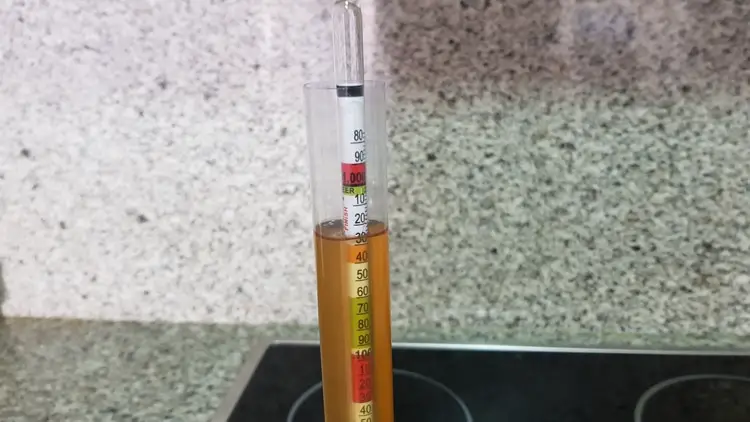
How to Add Specific Gravities
If you want to figure out how much specific gravity your honey will add to your beer, you’ll need to know the weight of your honey and your beer, as well as the specific gravity of each.
Follow these steps to estimate how much specific gravity adding honey will add to your beer:
- Measure the total volume of the wort prior to adding the honey
- Take a specific gravity of your wort
- Create a test sample of the honey you intend to use, as mentioned above, taking note of the specific gravity
- Measure the total volume of honey or honey water you intend to add
- Calculate the final specific gravity by multiplying the volume of the wort by the specific gravity and adding it to the volume of the honey multiplied by its specific gravity, then dividing it by the total volume.
For example, if the wort is 6 gallons and you have an original specific gravity of 1.25 SG, and you plan to add one gallon of honey at 1.06 SG, then your final SG will be (6 x 1.25 + 1 x 1.06)/7 = 1.22.
If you add the honey and water to the mixture prior to boil, then the honey will help increase the specific gravity.
However, it is possible that adding a honey and water mixture post-boil could reduce your final specific gravity, depending on how much water you mix into the honey.
Impacts on Carbonation
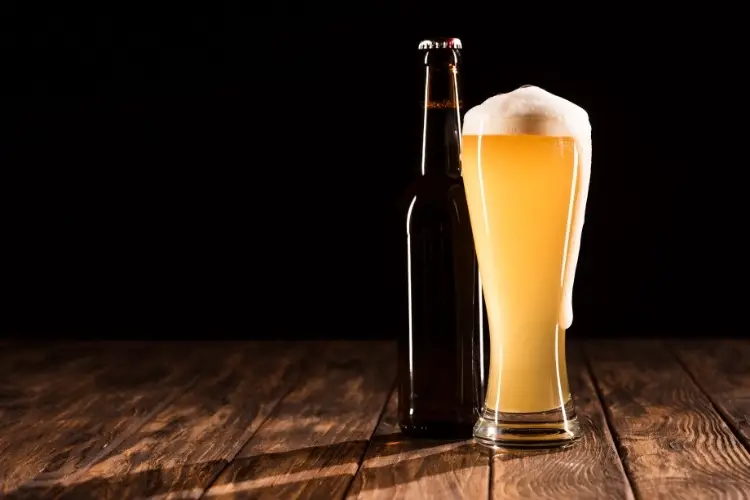
If you add honey during primary fermentation, ideally, the fermentable sugar should be completely fermented out and converted into alcohol.
However, if you add the sugar in a secondary fermentation after the yeast has finished, it’s possible that you will have residual sugar in your wort.
Honey takes a notoriously long time to ferment.
While normal beers only take a few weeks to finish fermentation, you may find that beers brewed with honey take even longer.
Be sure to take many specific gravity readings overtime to make sure that fermentation is really complete.
Even though you find that the specific gravity doesn’t decrease noticeably over a week, you may see the drop happen over several weeks.
When your brewing yeast reaches its target alcohol content, it may be difficult to carbonate your beer.
When the target alcohol content has been reached, the yeast may go dormant or die. You may need to add yeast nutrient or adjust the temperature of the beer in order to get the yeast to reawaken at a higher alcohol content to add carbonation after fermentation is over.
If your yeast goes dormant or dies and you’re not able to get carbonation, then you may be able to carbonate your beer using a CO2 cartridge or a kegging system.
If your yeast has not finished fermentation, but you want to prevent the yeast from fermenting any further, you can add a stabilizer to your beer.
A stabilizer causes the yeast to clump together, otherwise known as flocculation.
When the yeast cells clump together, they become heavier than water and fall out of suspension.
Stabilizing the beer will allow you to have some residual sugar in the beer, causing it to taste sweeter.
However, a stabilized beer will not be able to carbonate naturally. You will need to use a CO2 cartridge or a kegging system to carbonate your beer.
However, you can use honey in lieu of priming sugar to carbonate your beer.
Midwest supplies recommends adding a cup of honey for a five-gallon batch of beer to properly carbonate your batch.
Make sure to test the actual sugar content of your honey to confirm if this will be enough to reach your desired amount of carbonation.
Honey Comes in Many Forms
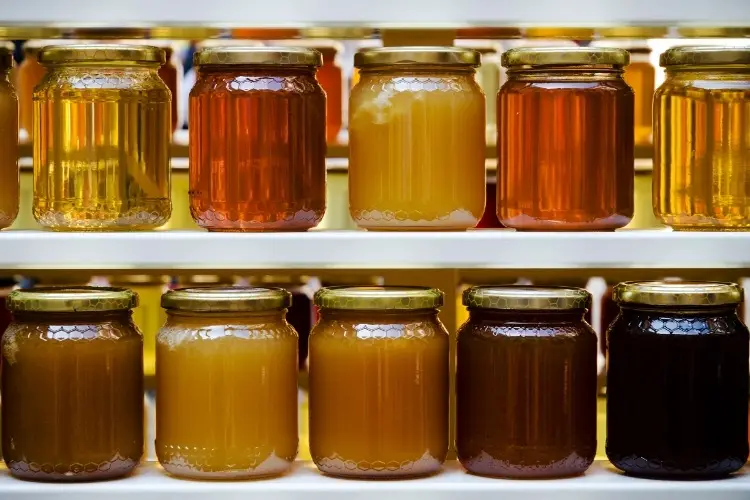
When you are considering different kinds of honey to add to your homebrew, make sure that you are purchasing high-quality honey.
Honey can come in many different flavors, depending on the type of flowers that the bees are eating when they make their honey, such as orange blossom or clover or lavender.
Each honey has a different flavor profile and sugar content that will impact the finished flavor of your beer.
The best way to figure out what type of honey you want to add your beer is to sample different types of honey.
Many farmers’ markets will have local farmers produce different types of honey for you to try. If you are buying in bulk, you may be able to negotiate lower costs than the rates that smaller cans, jars, or bottles typically go for.
Try to avoid bulk or cheap honey, targeting raw or unfiltered honey.
Brew Your Own notes that cheap honey that has been treated or pasteurized is typically very clear and consistent but lacks some of the chemical structure and composition of raw, unfiltered honey.
Some of the cheaper or bulk honey found in grocery stores may even have additional water added to make them more viscous, but the treatment also leaves them lacking in flavor and aroma.
Since honey can also be a very expensive ingredient, you may want to try your recipes at a much smaller scale.
One gallon batches will be easier to test and use a much smaller amount of honey.
Once you perfect the recipe, then you can scale upwards towards a five or seven-gallon batch.
Working With Honey
Honey can also be very difficult to work with.
Very thick, high sugar content honey will be very difficult to pour.
It will be very hard for you to be precise with getting your total weight or volume from the container the honey comes into your boil or fermenter.
To make it easier for you to work with your honey, try setting the container of honey in a pot on the stove.
Fill the pot with water, ideally until the honey is covered.
If the container is plastic, be very careful not to boil the water.
Keep the pot on a very low heat on the stove just enough to keep the honey warm.
Dissolving the honey into your beer can also be very difficult if both the beer and the honey are cold.
It is better to mix them when both the honey and the beer are warm such as right after the wort has finished boiling.
You can use a stirrer attachment to a drill to thoroughly mix the beer and the honey together, especially if you have a five or seven-gallon batch.
Note that when your beer and honey are warmer, it may be harder to get an accurate, specific gravity reading.
Calculators online can help you correct your specific gravity readings if the solution is warmer than room temperature.
Complimentary Ingredients
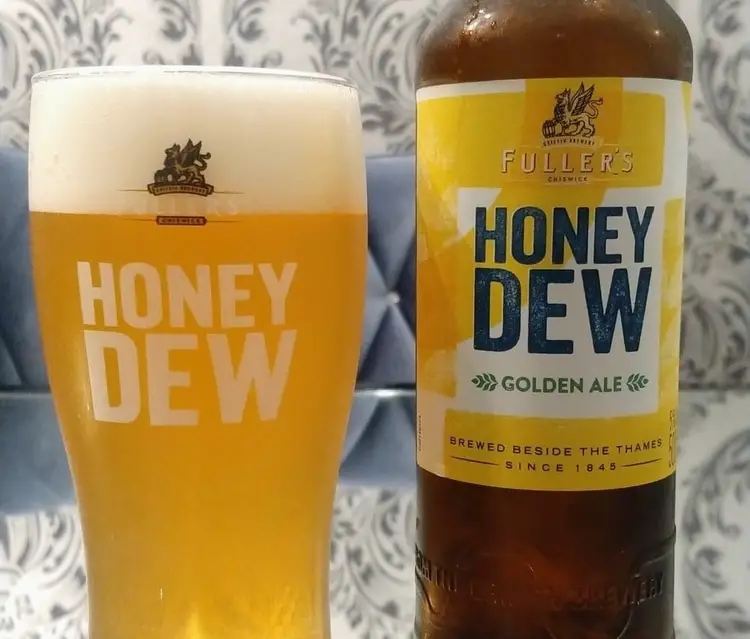
Many craft beer makers produce so-called honey flavored beers.
While adding honey may seem like the obvious solution to replicate these beers, many don’t even use honey as an ingredient.
These recipes rely on different grains to add honey flavor notes.
Northern brewer recommends a specially blended Honey Malt grain.
To bring out the honey flavor in your beer, you want to make sure that the other ingredients in your recipe will not overpower the flavor of the honey.
Super bitter hops or very strong dark greens may completely obscure the flavor of the honey, especially since you typically add a small volume of honey compared to the total volume of beer.
Many of the honey flavors in beers actually come from different types of greens that are used in the recipe rather than honey itself.
Consider using a hop like Northern Brewer’s Cascade Hops, and grain or malt like a Pilsner or light DME.
Even if you use honey in your recipe, you may not get very strong honey flavors.
Honey is a versatile ingredient for beer to produce a light, high alcohol content beer with subtle honey flavors and aromas.
However, homebrewers should take careful consideration of how they add honey to their recipe to achieve the best results.
